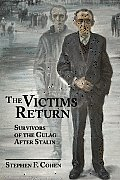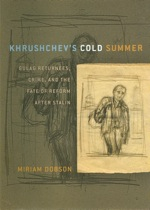As part of some work on Vasily Grossman (about which more anon), I’ve been catching up with my reading on Gulag history. Stephen Cohen’s The Victims Return finally arrived at the library, so I went to get it out.
The first thing that struck me was how similar its cover was to another recent book on Gulag survivors, Khrushchev’s Cold Summer by Miriam Dobson (2009).
The sketch on Dobson’s book is by B. Sh. Mkrtchian, ‘Out of the Camp’ (1955, Ivdel’lager, Museum of the International Organization Memorial). Cohen’s cover is a reproduction of ‘Aleksandr Istomin’s Crown of Thorns’, by Igor Soldatenkov. The double image on Cohen’s book, of the present Soviet citizen and former zek, is in the original (also reproduced on p. 56), whereas on Dobson’s the replication of the image is part of the cover design. In the former case, the idea of the past life still affecting the victims is obvious, but the shadowy duplication of the image in the background of Dobson’s cover expresses a similar idea, in a more subtle form, of the separation of the survivor from himself. It’s a concern that dominates Shalamov’s writing, as he attempts to work out how the person he is now can write about the things he experienced then (see, for example, Sententious and Glove, or the section Memory from his Memoirs). At the very least, I think, it must have been experienced by many former convicts as a sense of disruption or discontinuity. That isn’t remotely the theme of either of these books, which is a pity, although I shall try not to complain that other people haven’t written the books I wanted them to write.
Cohen’s is a much more traditional book, describing a historical narrative from the death of Stalin to the post-Soviet era. It is aimed more at a general than a scholarly audience, but it has unusual features, in that it functions not only as a collective biography of returnees, but also as an autobiography. Many of the author’s insights come from his relationships with Gulag survivors in the Soviet Union since the 1970s, most significantly Nikolai Bukharin’s widow Anna Larina and her son Yuri, to whom Cohen became very close whilst working on his biography of Bukharin. Charting this background and how he came to write the book adds an interesting dimension and places the subject in the context of East-West relations and scholarship.
But as a ‘collective biography’ I found the book problematic. Cohen is very clear-sighted about the fact that ‘Lives after the Gulag were almost as diverse as the human condition itself’ (p. 57), and there is certainly no facile generalization at work here. But in avoiding that pitfall, the book ends up becoming merely anecdotal, and there is no real attempt to theorize the experience or draw any conclusions from his rich material. There is not even a great deal of analysis of, for example, the cultural effects of the returnees’ presence that he describes. In fact the book seems more effective to me when it is focused more on political events, as in its discussion of Khrushchev’s role in restoring survivors, and the changing fates of returnees from the sixties till glasnost’. It’s a shame that a work based primarily on witness testimonies and questionnaires proves better at top-down history. It has to be said that Cohen gave Nanci Adler access to his archive, and she based her 2002 study The Gulag Survivor: Beyond the Soviet System on this material, so there was clearly no point in Cohen simply repeating her findings, but I still felt a bit more could have been made of it.
One other significant criticism: there is a tendency to assume that narrative voices and views expressed in fictional or fictionalized works can be uncomplicatedly equated with the author (e.g. a quotation from Everything Flows is prefaced with ‘As Vasily Grossman recalled…’, p. 41, and the words of character in Shalamov’s story Epitaph are put into the author’s mouth, p. 72). Cohen is far from the only historian I’ve come across who makes this mistake, but the concept of the real and implied author, and the narrator, is really not that difficult – essentially, it’s only a question of being careful in one’s wording. This is not a trivial matter, particularly in an area of study that relies so heavily on written testimony, of survivors and others, in both memoir and fictional form.
Miriam Dobson’s book, although dealing with a shorter time-frame (1953-64), has a wider scope, in that her emphasis is on the impact of criminal as much, if not more, than political returnees, and she explores more broadly responses within different levels of Soviet society to the death of Stalin, changes in the political culture, and attempts at reform. The picture she paints of the reintegration (or otherwise, as was frequently the case) of Gulag returnees into Soviet society is ‘complicated and messy’ (p. 237), with no overarching narrative of return emerging, but it does become clear that while many Soviet citizens welcomed the end of the Stalin era, significant parts of society still had difficulties in accepting the changes that were being made, were antagonistic towards former convicts, and fearful that Soviet values were being undermined.
The result of extensive archival work, Dobson’s methodology is in large part based on analysis of unpublished letters to the Soviet press and petitions to political figures, showing the extent to which they conform to, or diverge from, official rhetoric. She demonstrates convincingly the importance of the language of these letters, as citizens tried to adopt the new discourse of legality (zakonnost’ – a key term in the Khrushchev era), or persisted with the old, more militant rhetoric, adapted to the requirements of the new situation. As she states, discussing the perception that criminality was out of control following the release of so many prisoners, ‘The Stalinist vision of a world beset by deadly foes provided a template for further vilification of the criminal as an alien and enemy to Soviet society. Although these visions of the offender were not articulated in official sources in the 1950s, they recur with remarkable similarity in a large number of citizens’ writings.’ (p. 170)
For me, some of the most interesting sections were those dealing with cultural questions. The exploration of the importation of a ‘Gulag subculture’, in the form of tattoos, songs, etc, and its effects on mainstream Soviet society, particularly amongst the young, reminds us that far more criminal than intellectuals were incarcerated in, and returned from the Gulag. One only has to imagine some of the thieves Shalamov depicts released into society to understand the consequences and the alarm of many ordinary people. Dobson completes her study by examining popular attitudes to two significant (counter-)cultural figures in the early 1960s, Aleksandr Solzhenitsyn and Joseph Brodsky. The publication of One Day in the Life of Ivan Denisovich, unsurprisingly, provoked a good deal of correspondence, with many readers horrified at the vulgarity (poshlost’) of his language, which awakened fears that ‘respectable’ Soviet culture was being forced out (pp. 219-22). The persecution and prosecution of Brodsky as a parasite, meanwhile, is shown to have been motivated as much by a determined volunteer (druzhinnik) disgusted at the poet’s unconventional lifestyle and behaviour as by the KGB (pp. 228-32). Looking at the Soviet Union from the perspective of the Cold War, figures such as Solzhenitsyn and Brodsky assumed huge importance; Dobson balances that view by showing that their marginalization within Soviet society was not solely the product of official policy.
Covering judicial, social and cultural changes as much as attitudes towards Stalin and the Party both before and after Khrushchev’s not-so-secret speech, Khrushchev’s Cold Summer provides some fascinating and unexpected insights into a society in transition, and disturbed not only by revelations about the past, but also the instability of the present and future. It also depicts a citizenry endowed with far more diversity and agency than is frequently assumed to be the case in studies of Soviet history and politics.
- Stephen F. Cohen, The Victims Return: Survivors of the Gulag After Stalin (London and New York: I. B. Tauris, 2011)
- Miriam Dobson, Khrushchev’s Cold Summer: Gulag Returnees, Crime, and the Fate of Reform after Stalin (Ithaca and London: Cornell University Press, 2009)


